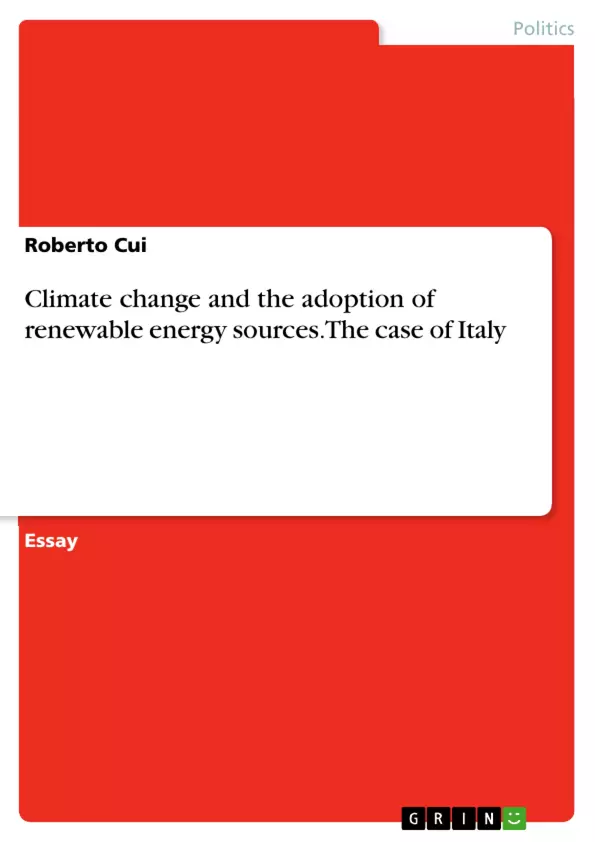As almost unanimously acknowledged, human activities, such as industrial production, agriculture, household heating and cooling, transportation, and – last but not least – energy generation, are the main cause of climate change. The United Nations – just to cite an eminent international institution which is dealing with the issue, recently recognised that: “Global warming is unequivocal, human influence has been the dominant cause since the mid-20th century, and atmospheric concentrations of greenhouse gases […] will persist for many centuries.” The Working Group I of the Intergovernmental Panel on Climate Change, in its contribution to the Fifth Assessment Report, states that “human activities are continuing to affect the Earth’s energy budget by changing the emissions and resulting atmospheric concentrations of gases and aerosols and by changing land surface properties.”
All the human activities mentioned above produce a negative externality: they release Greenhouse Gases (GHG) Emissions to the atmosphere.
At the international level, thirty-nine countries signed the Kyoto Protocol on 11 December 1997, which entered to force on 16 February 2005 and sets internationally binding emission reduction targets. In December 2012, the parties adopted an amendment to the Protocol, and seven other nations joined the previous signatories. The obligatoriness of the targets set by the Kyoto Protocol has not been completely fulfilled by the countries which agreed to them. The principal reason, as highlighted by the Harvard Magazine in 2002, is that the way the Protocol was drafted is “economically inefficient, unobjective, inequitable, and – worst of all – ineffective. […] The original agreement outlined in Kyoto committed individual countries to reduce their CO2 emissions to below-1990 levels. But the choice of 1990 immediately introduced inequities into the ensuing political process to determine who should cut how much.” Nowadays, the Protocol is joined by 192 parties.
The European Union has been implementing climate change tackling policies since 1991, when the first “Community Strategy to limit Carbon Dioxide emissions and improve energy efficiency” was issued. The first European Climate Change Programme, issued in order to enhance the possibilities to fulfil the requirements of the Kyoto Protocol was launched in 2000 and it lasted until 2004.
The aim of this work is to analyse the fundamental actions implemented by Italy as regards Climate Change policy. As a
Inhaltsverzeichnis (Table of Contents)
- Introduction: the fight against Climate Change at the global, EU, and national level
- A general view of the Italian situation
- The Italian Energy Mix
- The Italian Renewable Energy Sector
- The Italian Legislative Framework
- The Italian National Energy Strategy
- Criticisms and Recommendations
- Future Scenarios
Zielsetzung und Themenschwerpunkte (Objectives and Key Themes)
This paper aims to analyze Italy's climate change policy, focusing on the role of renewable energy sources (RES) in achieving a low-carbon energy sector. The paper examines the legislative framework, identifies criticisms, and proposes recommendations for future development. Key themes include:- Climate change mitigation and the role of renewable energy sources
- The Italian energy mix and dependence on imports
- Analysis of the legislative framework governing RES development
- Challenges and opportunities for achieving a low-carbon energy sector
- Recommendations for policy improvements and future scenarios
Zusammenfassung der Kapitel (Chapter Summaries)
- Introduction: the fight against Climate Change at the global, EU, and national level: This chapter introduces the global context of climate change, highlighting the role of human activities in GHG emissions. It outlines the international efforts to address climate change, including the Kyoto Protocol and the European Union's initiatives.
- A general view of the Italian situation: This chapter presents an overview of Italy's energy mix, highlighting its high dependence on imported energy sources and the resulting challenges of high energy prices and security of supply.
- The Italian Energy Mix: This chapter details the composition of Italy's energy mix, analyzing the share of different energy sources in its primary and final energy consumption.
- The Italian Renewable Energy Sector: This chapter explores the development of the renewable energy sector in Italy, examining the current state of RES deployment and the potential for future growth.
- The Italian Legislative Framework: This chapter analyzes the key legislative instruments governing RES development in Italy, including the Renewable Energy Directive and relevant national policies.
- The Italian National Energy Strategy: This chapter examines the objectives and key elements of Italy's National Energy Strategy, focusing on its vision for a sustainable and competitive energy sector.
- Criticisms and Recommendations: This chapter critically evaluates the Italian climate change policy framework, identifying its limitations and proposing recommendations for improvements to facilitate the transition to a low-carbon energy sector.
Schlüsselwörter (Keywords)
Climate change, renewable energy sources, energy mix, energy dependence, legislative framework, National Energy Strategy, low-carbon energy sector, GHG emissions, Italy, European Union, Kyoto Protocol, Directive 2009/28/EC.- Quote paper
- Roberto Cui (Author), 2014, Climate change and the adoption of renewable energy sources. The case of Italy, Munich, GRIN Verlag, https://www.grin.com/document/282684



